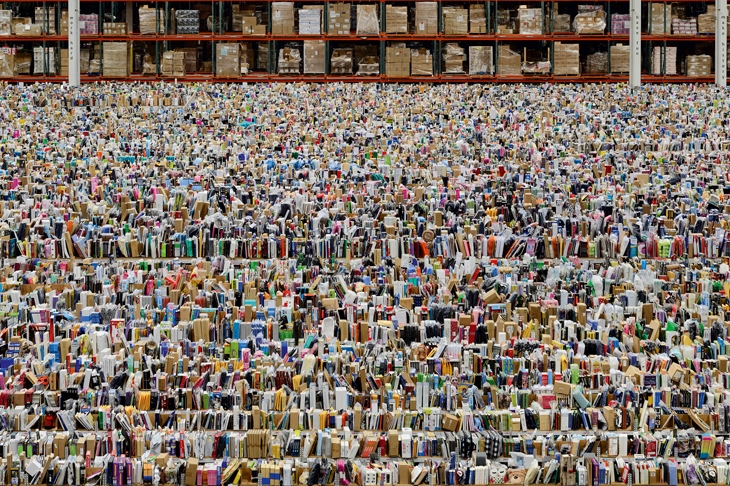Walking around the Andreas Gursky exhibition at the Hayward Gallery, I struggled to recall what these huge photographs reminded me of. Gursky has built a career on colossal, panoramic pictures of subjects that are extremely ordinary — the view from a departure lounge of the empty runway at Schiphol airport, for example. Or, yet more exquisitely uninteresting, a wall-sized image of a section of beige carpet in an art gallery.
Then I got the connection that had eluded me. These pictures were much like Martin Parr’s little books of Boring Postcards. These are collections of real cards made over the years by the British photographer, with separate volumes devoted to items from the USA and Germany (the latter entitled Langweilige Postkarten).
Some are so transcendently, unutterably dull as to make you laugh out loud. For example, one from the American selection shows a dismal section of dual carriageway, the grass in the central reservation parched, a single vehicle in the middle distance and above, inscribed in jolly yellow letters, the words, ‘Traveling on Beautiful Interstate 35’.
That Gursky’s work is often like that isn’t so much a criticism as an observation. ‘Breitscheid Intersection’ (1990) depicts a stretch of thoroughfare even more devoid of visual fascination than Interstate 35 — except that some ant-like workmen are laying a grid on the embankment, presumably to prevent it eroding. Unlike postcards, however, Gursky’s pictures are blown up to a heroic scale.
They are up to four yards wide and, technically speaking, magnificent. ‘Paris, Montparnasse’ (1993), one of his most ambitious pieces, depicts the largest housing development in the French capital — a vast filing cabinet for human beings — in such precisely focused detail that when you move close in you can make out the furnishings behind each of the hundreds of windows. The effect is brilliant and lowering at the same time.
Now in his early sixties, Gursky was taught at the Düsseldorf Academy of Art by Bernhard Becher who, with his wife Hilla, took many photographs of such things as old gasometers, water towers and grain silos. These were all in black and white, neutrally lit, and arranged in grids. The Bechers thus established what you might call a poetics of dullness. But with them it was the idea that counted. In contrast, Gursky, whose father was a commercial photographer, is far more adept at the practicalities of camera and editing. ‘Paris, Montparnasse’, for example, is spliced together from a series of shots so as to remove, as if by magic, the perspective recession that would result from any single snap of an enormous oblong structure.
Also, unlike the Bechers, Gursky riffs constantly on the history of art, old master painting in particular. The romantic landscapes of Caspar David Friedrich were a frequent reference point in his early work. The difference is that Friedrich typically depicted people confronting the infinite in the form of mountains, sky and sea. But when Gursky takes a picture of sublime scenery, such as ‘Klausen Pass’ (1984), it’s to point out how hikers on the lower slopes are cluttering it up.
Clutter is one of his themes. ‘Amazon’ (2016) presents a vast plain of heterogeneous stuff in the eponymous firm’s warehouse in Phoenix, Arizona. Scenes of frenetic crowding — a rave in Dortmund seen from aloft, or the Tokyo stock exchange — are another preoccupation. The reference here seems to be Hieronymus Bosch, or perhaps Bruegel.
Gursky’s recent work is more likely to bring abstraction to mind. His series of aerial images of the sea look a lot like action paintings by Jackson Pollock, Sam Francis or Franz Kline — except that when you look closer at the rippling water in ‘Bangkok VI’ (2011), you notice rubbish floating on the surface.
The joke in Parr’s boring postcards comes from our loss of love for the modern world. It seems hilarious that anyone could have considered buying these cards showing motorways, shopping centres, petrol stations and nondescript 1960s hotels, then sending them with a cheery message: wish you were here. Gursky, too, is keen to stress that the world is utterly lacking in enchantment.
Generally, this does not seem to be an amusing matter for him, but one of his works is almost as comic as Parr’s. It is a digitally edited image of four German chancellors — Merkel, Schröder, Kohl and Schmidt — sitting contemplating Barnett Newman’s great minimalist abstraction ‘Vir Heroicus Sublimis’.
David Hockney once complained, after seeing a Gursky, that Picasso and Matisse had made the world look very interesting, while photography makes it look dull. It’s true that the camera is very good at that. But this is Gursky’s subject: not man, heroic and sublime, which is how Newman’s title translates, but humanity, prosaic, mundane and extremely messy. Of course, he may be right about that.






Comments